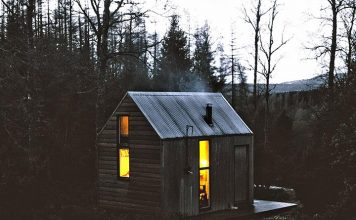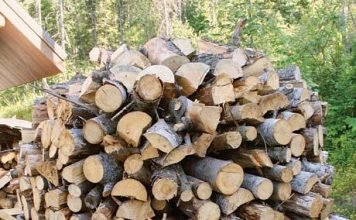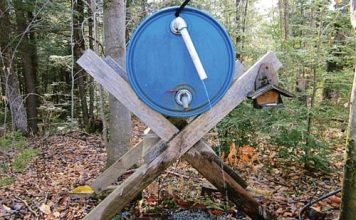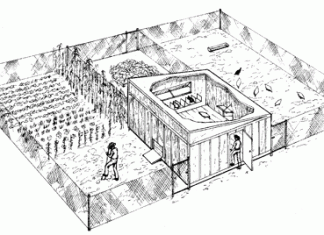| By Dorothy Ainsworth |  |
| Issue #90 • November/December, 2004 |
Standing tall like a giant sunflower in a sea of undulating prairie grasses, or in any rural setting, a windmill is a thing of beauty. Not only are water pumping windmills a joy to watch, but they are incredibly useful. Powered only by wind, they work like quietly-purring nonpolluting creatures, to keep our storage tanks overflowing with fresh water. They operate effortlessly, efficiently, reliably.
History of the windmill
Windmills have been around since the Middle Ages. The first recorded evidence of windmills being used for pumping water and grinding grain was in 7 AD in Persia. Then China got ahold of the idea and it spread to Asia, Africa, and the Mediterranean. The European mill appears to have developed independently from the others because the design is so different. The predecessor to our modern windmill dates back to France in 1105 and England in 1180. In the 14th century, the Dutch took windmills to a whole new level with their “tower” mills using canvas sails stretched across four wooden lattice frames like a big X. Their objective was moving enormous amounts of water into higher basins and canals. By the end of the 16th century thousands of windmills were pumping and grinding in western Europe. By the late 19th century, the count was 30,000and, miraculously, there was still enough wind to go around.
The American windmill
The American multi-bladed windmill bears little resemblance to its European counterpart. Unlike the Dutch “scoop” mills that could move 16,000 gallons an hour but only lift it 16 feet, the new Yankee design could lift water from hundreds of feet below the surface. It was invented in Connecticut in 1854 by a young mechanic named Daniel Halladay. Its wheel, made from wooden “sails,” could be transported in sections and assembled on location.
He ingeniously designed the wheel to automatically turn its face into the wind by wind pressure on the vertical tail behind it. If it got to spinning too fast, a weighted mechanism came into play that turned the wheel partially out of the wind to slow it down.
Halladay sold thousands of his machines, and before long there were 300 competing manufacturers producing similar wooden-bladed beauties. Then in 1886, Thomas Perry designed the more aerodynamic steel-bladed windmill, with curved blades (to catch more wind) and that design is still used today.
The windmill pump cylinder. Each up-stroke (figure on right) pulls a certain amount of water into the cylinder, but on the down-stroke (left) a check valve in the bottom won’t let it be pushed out, so the water has nowhere to go but up with the next upstroke.
In the late 1880s and early 1900s, windmills were sprinkled all over the American landscape. They were indispensable to the late-comer settlers who were forced to move farther west to the sun-parched remote plains, after all the more desirable spots near rivers and streams had been taken. In the Great Plains and the vast territory known as the Great American Desert, water was more precious than gold.
Windmills were also indispensable during the construction of the railroads to provide drinking water for the crews and to supply water for the steam locomotives. Workers erected a windmill and an adjacent storage tank every three miles along the tracks. Some of the railroad mills were 30 feet or more in diameter.
That entire chapter of history is written in the wind, the wind that powered those windmills. There would have been no life, hence no progress, without water.
Windmills were once status symbols. In 1910, a farmer or rancher who could afford the best Sears & Roebuck “Kenwood Back-Geared Galvanized Steel Pumping Model” with red painted tips on the vanes and tail ($25) had something to crow about. Poorer homesteaders had to make their own mill heads and towers out of wood.
The most common practical uses for a windmill are to irrigate pastures and gardens, water livestock, and supply and aerate ponds. Anything more than that requires a holding tank on “stilts,” or a water tower, to provide enough pressure to be “on tap” for household use.
The windmill, barbed wire, and the six-shooter were the “big three” technological advances in those days.
The great windmill boom lasted for over 50 years. Between 1880 and 1935 more than 6 million windmills were sold by about 20 manufacturers. But, sadly, the big spinning wheels came to a screeching halt in the early ’30s with the advent of federally subsidized power to remote farms and homesteads. The REA (Rural Electrification Administration) made it possible for people to use electric pumps delivering 20 to 30 gallons of water a minute, and that drowned out the windmill era. By 1970, only three companies in the U.S. produced water pumping windmills: Aermotor, Dempster, and Baker Monitor, and they are still around today.
|
How a windmill works
The windmill’s wheel (fan) has 15 to 40 galvanized steel blades which spin around on a shaft. The shaft drives a geared mechanism that converts rotary motion to an up-and-down motion like a piston in a car engine. That motion drives a long pump rod (aka sucker rod) going up and down inside of a pipe in the well. Attached to the end of the pipe is a cylinder with a sealed plunger going up and down in it that forces the water up the pipe. The seals (cupped seals that ride up and down in the pump-cylinder) are called “leathers.” (Neoprene instead of leather is used in most cylinders today.) Each up-stroke pulls a certain amount of water into the cylinder, but on the down-stroke a check valve (aka foot valve) in the bottom won’t let it be pushed out, so the water has nowhere to go but up (with the next upstroke). It’s a simple efficient design that has remained virtually unchanged for more than 100 years.
An average windmill (6 to 8 foot-diameter wheel) spinning in a brisk breeze (15 to 20 mph) will pump about three gallons a minute whenever the wind blows (about 35 percent of the time in many areas). That adds up to about 1500 gallons a day. Another example of output could be calculated by using a 10 to 12-foot wheel pumping against a theoretical 100-foot head (the column of water lifted from the static water level to the tank). This larger windmill will pump an annual average of 4500 gallons per day, or 1.63 million gallons of water a year. This figure is based on moderate winds (8-12mph) blowing part of the time, running the mill at half its rated capacity, and brisk winds (15 to 25 mph) blowing about 30 percent of the year and running the pump at maximum capacity.
Wind speed has an important effect on pumping capacity. Below certain speeds the mill can’t “get going.” Above 25-35 mph (depending on the model) the windmill’s overspeed controls limit the output by turning (furling) the direct face of the wheel out of the main wind direction. This design feature protects the windmill mechanism, but it also limits the pumping rate no matter how fast the wind blows.
|
There is an optimum wind speed for every windmill size and model. The number of vanes (sails) in the wheel increases its sensitivity to low wind speeds (to get started), but other factors such as fan diameter, the depth of the static water level in the well, and cylinder size all play a part in output capacity. (“Static” water level is the measurement from the top of the well casing to the water surface down in the wellnot the depth the pump is set.)
Uses for a windmill
The most common practical uses for a windmill are to irrigate pastures and gardens, water livestock, and supply, and aerate ponds. Anything more than that requires a holding tank on “stilts,” or a water tower, to provide enough pressure to be “on tap” for household use. I placed my water system on top of a hill so the water is gravity-fed for all my needs on the property. (More about my system later). I love the idea that if the power fails, I’ll still have fresh waterlots of fresh water. To me, that’s self-sufficiency and a nice sense of security. Evidently a lot of backwoods people feel that way because windmills are making a comeback. Aermotor claims that sales of windmills, both for generating electricity and for pumping water, are increasing worldwide, and more windmills are pumping water today than at the turn of the century.
Is a windmill for you?
If you are contemplating putting up a windmill on your property, the first consideration is to determine whether your site and your budget can accommodate one, then scout out the best location for it. A basic rule of thumb is to place your windmill a minimum of 25 feet above any obstructions within a 150-foot radius.
|
Next, set up an anemometer or wind odometer to measure wind speed and volume over a period of time ( a year is good). You can buy or rent a wind odometer that will measure the number of miles of wind that runs past your site. Divide that figure by the total hours it ran and you will get your average wind speed for the site. You can also call the local airport and weather station for comprehensive wind data in your area.
Having a well drilled
First you’ll need to obtain a permit from the local county offices.
Next, call a good reputable well driller (from the Yellow Pages under wells and pumpsor by word of mouth) and see what he can do for you. If he predicts the water is somewhere else on your property other than the site you picked, you’ll have to do some compromising.
The going rate to have a well drilled is about $15 per foot here in southern Oregon (surprisingly the same cost as back in 1981 when I had my two wells drilled). That figure includes the steel well casing installed in 10 to 50-foot lengths (depending on your soil) and possibly a well liner all the way down (4 to 6-inch PVC pipe). Some soil stratification requires a well liner to keep the fractured strata from caving in on the well.
Chances are you’ll hit a good water table between 100 and 400 feet, the average depth being 250 feet. Figure a well will cost you somewhere between $1500 and $6000. (Of course there are no guarantees; these are just average ballpark figures I gleaned from well drillers around this dry and spotty valley. Some parts of the U.S. may not have a water table anywhere near the surface and for all practical purposes, no matter how deep you drill or how much money you have, you may never hit water at all.)
|
The good news is that you won’t have to drill to China in search of huge volumes of water because a windmill only pumps a few gallons a minute anyway. You can tell your well driller in advance to stop drilling when he reaches a depth that fulfills your limited requirement.
Even a five-gallon-per-minute (gpm) well would be sufficient for a small windmill. There would be very little, if any, “drawdown” because the refreshment rate would be greater than the pump rate. Drawdown is the measurement of the static water level going down, down, down, as water is being used out of the well. A well with a windmill on it is constantly being replenished (static water level going up, up, up) when the wind is not blowing.
There are two distinctly different methods of drilling a well. There is the rotary method, where a big auger on a boom truck drills a deep clean hole (not unlike a drill bit in a hand drill) and “hits” water when it gets to a water-bearing layer (aka water table). The other method is called “cable drilling” and basically “hammers” a hole through rock and other strata, fracturing everything in its path, causing each layer it goes through to release its water (if it has any). Proponents of this method claim they get more water all the way down than the conventional rotary method delivers. The geological debate can get downright steamy on this “dry” subject.
Finding, installing, and maintaining a windmill
After your well is drilled, cased, and capped with a well seal (and the water is tested to make sure it’s safe) it’s time to size the windmill that will fit your well and your needs. If you want a new windmill, contact the three major manufacturers (mentioned previously) and ask for brochures, price lists, and installation fees.
|
If your budget decides that you must buy a used one, there are sources on the internet and ads in farm journals, etc., to help you find one. Thousands of good used ones are available all over the U.S. Do your research and it will pay off. Keep in mind, though, that most used windmills will need some rebuilding work, but parts are available for most models, and there is no problem getting parts for Aermotor, Dempster, and Baker Monitor.
Here in southern Oregon there is a guy I call “The Windmill Man” who is passionate about windmills and knows “pert’near” everything about every model ever made. He not only sells, installs, and repairs used windmills, but he has a huge collection in his own in his yard. (See photos)
He’s the “real deal,” an authentic craftsman who is trustworthy, knowledgeable, and skilled. If a windmill has a broken part that can’t be found, he makes it. If a windmill system needs customizing or improvising, he does it. For years he has done the maintenance work on my 1942 “David Bradley,” an old Sears model I bought in 1982 for $450, and it’s still going strong.
Windmill maintenance
Maintenance on a windmill is minimal: 10-weight oil or ATF (automatic transmission fluid) in the gears should be changed every year, a little grease in the bearings in the “turn-table” (between the gearbox and the top of the tower) applied at the same time, and the leathers replaced every two to six years, depending on how much sand you have in your water.
A thing called a “stuffing box”(usually solid brass) has to be repacked and the nut tightened occasionally. This curious-sounding component is a simple design and an easy to understand concept if you see it working, but hard to explain on paper. It’s what caps off the top of the well’s pipe (the cylinder is at the bottom of the pipe).
|
The pump rod goes up and down through a hole in the stuffing box (which is “stuffed” with graphite rope). This stuffing (aka packing) allows only enough water to leak out around the hole to lubricate the up and down action of the rod.
When the packing gets old it allows too much water to squirt out. Then it’s time to unscrew the nut on the unit, put some more packing in, and tighten the nut down good and tight. Without the stuffing box there would be metal rubbing on metal, wearing the rod away in no time. Same thing would happen without seals on the cylinder plunger.
A stuffing box is only needed on a windmill if you have to pump water uphill to a tank, but not needed if your water will go downhill to a storage tank, or horizontally into a watering trough or pond.
A cheap irrigation tank and water tank flag
My property is a hilly piece with the well down below and the water storage tank up above. There’s a quarter mile of pipe and 165 feet of head (rise) between the two. The well driller confidently predicted that my “big water” was at the bottom of the hill, so after the well was in I had to dig a long trench to bury the water line all the way to the tank at the top of the hill. That gut-busting labor turned out to be a blessing in disguise because now gravity works in my favor.
I built a 10,000-gallon water-storage tank out of concrete (12’x12’x12′), put a roof on it, and screened the space between the tank and the rafters for ventilation. Then, so I could check my water level at a glance from anywhere on the property, I put a brightly-colored flag on a pole that goes up and down through a hole in the roof. The wooden pole and its PVC guide (sleeve) is set into a five-gallon bucket of air with a sealed lid on it. The bucket floats on the water level. (See photo.) The pole could be calibrated, but that would require getting the binoculars out to read it, so just plain “high” and “low” is good enough for me.
|
When the flag is almost dragging on the roof I know it’s time to click on the 35 gpm, 2-HP pump down below and set the timer for about four hours. When the flag is dancing in the breeze three-feet above the roof, that means the water tank is fulland I’m happy.
I built the holding tank to eliminate the need for a captive-air tank in the pump house (small steel water-tank with an “air bladder” inside). It works on a pressure-gauge system that turns the submersible pump on and off constantly as the bladder compresses or expands (when the tank fills and empties). This action eventually wears out the pump’s starting capacitor. With 10 thirsty acres to irrigate, the pump would have had to cycle on and off every few minutes all summer long.
My stored water supply is gravity-distributed for irrigation and household use upon demand via a maze of pipelines and on/off valves (non-siphoning type) that staggers even my imagination and I’m the one who did it. As I developed the property over the years, I crisscrossed the land with thousands of feet of additional water lines as needed. I used inexpensive ¾-inch utility polypipe (about 7¢/ft.) for landscape irrigation, and poked a hole or two with an ice pick wherever I planted a bush or tree. It’s the poor man’s answer to drip irrigation.
This gravity-feed system and flag-pole alert has worked great for 20 years now. I’m so glad I bought a hill to live on. Gravity is free and gives me 70 lbs. of water pressure down below and 40 lbs. at the house (the halfway point on the hill), which is plenty. (Figure every 100 feet-of-head equals 43 lbs. pressure). Since I use a drip irrigation system, even low pressure up near the tank works fine.
For long-range self-sufficiency and in case the power goes off, I put in a second well (low-capacity) adjacent to the holding tank, and put a small windmill on it (six-foot diameter wheel). Whenever the wind blows, which is often, it pumps two gpm into the tank and supplements the water supply. An overflow pipe exiting the top of the tank feeds a small pond that nature has generously stocked with frogs and mosquitoes. The county vector supplies free “mosquito fish,” hardy little critters that vacuum up mosquito larvae faster than they can hatch, so everything balances out.
|
I planted hybrid poplars around the pond, and they grew huge in no time, so now I have a shady oasis to hide in from the summer sun while the dogs jump in the pond and cool off. Life on the hill is good. The windmill purrs and the frogs croak.
Years ago I almost let a fast-talking salesman sucker me into buying an elaborate and expensive water-level gauge system of brass and copper ball cocks and levers floating in the tank (like a toilet-flushing mechanism) that would turn my pump on and off automatically when the water went above or below a certain level, “While you sit in your easy chair eating chocolates,” he said. It sounded like a good idea (the chocolate part), but it would have required a quarter mile of buried electrical cable and a complicated hook-up system.
My water is high in calcium and other minerals so every part would have already corroded beyond recognition and jammed up. Being “economically-challenged,” I came up with a cheap solution and sent “Mr. Bells and Whistles” on his way. (Instead of eating candy, I run down to turn the pump on and stay slim.)
My advice to new land owners is to think long and hard before buying gadgets that will eventually need repairs or replacement. Think long-range, think simplicity, think self-sufficiency. That’s what the “Backwoods Home” philosophy is all about.
The three illustrations that accompany this article are from The New AlchemyWater-Pumping Windmill Book by Gary Hirschberg. Copyright by the author and reprinted with permission from St. Martin’s Press, LLC.
Learn more about Dorothy and/or contact her at her website www.dorothyainsworth.com


























I have come to have 3 win milld here in New Zealand. One is a “Self Oiler” (Year of manufacture or age is unknown)
A Kiwi made “Hayes” windmill of approx 1950.
A Star Steel Back which I would live to find a couple of replacement gears for and I understand is dated to around 1890 to 1919.
My question are….
The 2″ bore is old and unused for approx 40 yrs.
I wish to pump bore water into the 2 x 2000 USA gallon water tank which have their inlet pipes are positioned at about 10 feet above ground level of the Bore.
Is it possible for the windmills piston action pump, to push the water up to a possible header tank instead, when the top of the header tank is approx 20 feet above the pump?
If the answer is no, how far can I expect the pump to bee able to push the water?
With thanks,
Will.
From near Christchurch
NZ.
We recently purchased a property with a decommissioned windmill on the roof of a pumphouse to power the well pump inside. Where can we find instruction on how to add electrical grounding, as the metal blades might be subject to lightning strike? Thank you very much for your article, and any specific guidance on this question.
Very Good Article. I am loving all the details (as a novice I am loving it more). Step by step explanation. I have drilled a well and getting 6 to GPM water at Middleburg, VA. I want to put in a windmill to pump water for my cows/horses. This is the plan, I am not there yet. Once again thanks for the details.
what is the weight of a 10m windmill average
Smart article. We found an old windmill in our woods the other day with a 5gpm well under it. Trees have totally engulfed the tower. It was a pleasant surprise. We sold our atv and now use a wheelbarrow to move our wood. A great work out and 0 maintenance. Thanks for writing.
With the old wind mills I’ve seen out in the middle of Washington that were there to pump water, one revolution of the blades would produce how many gallons in one revolution. is there a calculation of how many gallons it would produce?? thank you if you can answer that.
Can you use pvc pipe as a rod on a water well wind mill
You made a good point that you will need to get a well driller for a water pumping windmill. I’ve been wanting to have a water pump on my property to help get access to groundwater. Maybe I should get in touch with a professional in water bores and see what I’ll need to get started.
Very well written and paid attention to all the important details for the average Joe
As an owner of a drilling company you are spot on. All landowners should think hard about repairs of the systems they have chosen. I see first hand everyday the effects repairs can have on families. We focus a lot on windmill wells, developing springs, and solar wells for livestock. Spending time and researching all the amazing options is critical if self sufficiency is the ultimate goal.